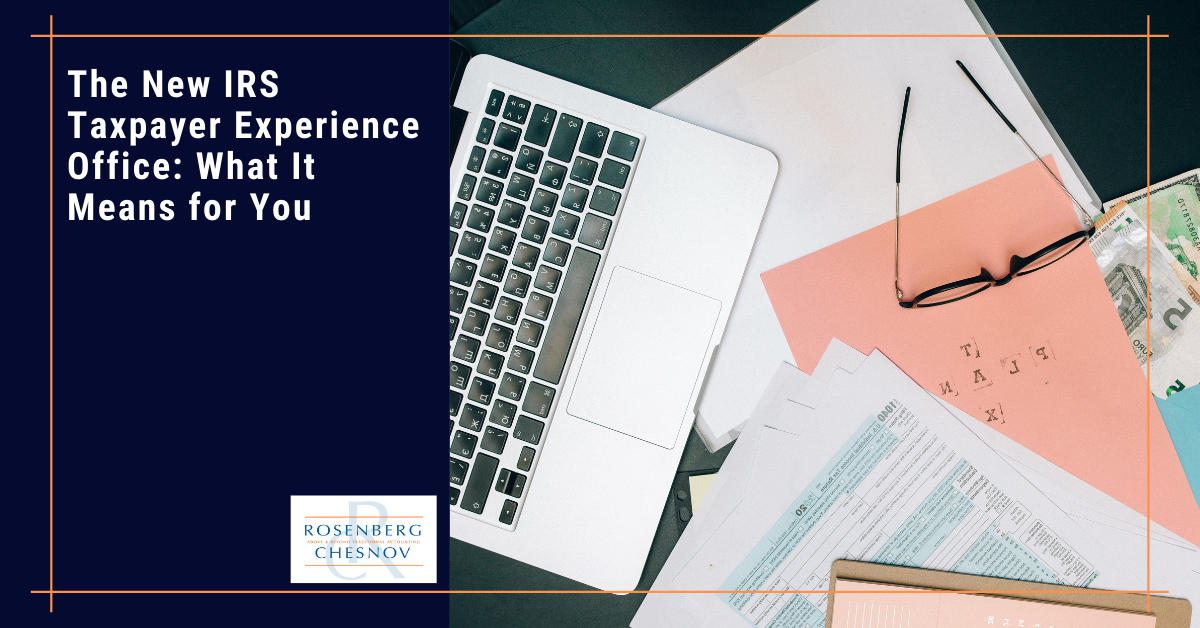

Maximize Your Green Business Tax Savings
Category: Business
It’s no secret: The IRS has not always excelled when it comes to taxpayer services.
In fact, with an unprecedented number of returns requiring manual review due to new provisions, issues like processing and refund delays, discrepancies and errors from both taxpayers and the IRS, and lack of information or communication have significantly increased since the pandemic.
Fortunately, the IRS has committed to a long-term plan to improve customer service issues. They have recently unveiled a significant component of this effort: the first-ever Taxpayer Experience Office (TEO).
The brand–new office will focus on all aspects of taxpayer transactions with the IRS and may yield an immediate boost in responsiveness, functionality, options, and services for taxpayers.
Keep reading to learn more about how the Taxpayer Experience Office could make life easier for you at tax time.


The announcement of the new office comes in the wake of a report to Congress from the National Taxpayer Advocate, released in January. The report details the processing issues that led to dramatic backlogs and refund delays from the 2020 tax season and warns that the outlook for the 2022 filing season is not good. To quote the report: “The IRS is in crisis.”
The IRS’s report to Congress, issued the same month, proposed over a hundred different new programs and tools to improve service issues. The Taxpayer Experience Office is a part of that plan.
“As the IRS continues taking immediate steps this filing season, including adding more employees to address the significant challenges facing a resource-constrained IRS, it’s critical that we work to equip the IRS to be a 21st-century resource for Americans,” said IRS Commissioner Chuck Rettig. “The formal establishment of this office will help unify and expand efforts across the IRS to improve service to taxpayers.”
The TEO will identify changing taxpayer expectations and industry trends, focus on customer service best practices, and promote a consistent voice and experience across all taxpayer segments by developing agency-wide taxpayer experience guidelines and expectations. The office will be adding staff in the coming months to help support the effort.
“Whether checking the status of a tax return, meeting with a revenue agent for an audit, or receiving a tax credit to their bank account, improving service delivery and customer experience are fundamental priorities for us,” Corbin said. “We’re committed to designing and delivering services that better connect with our diverse taxpayer base.”
Some of the areas of improvement in the near term include expanding customer callback, expanded e-File and payment options, digital signatures, secure two-way messaging, online accounts for business and tax professionals, and more services for multilingual customers.
The improvements promised in the new initiative build on other recent innovations, such as digital tools to support Economic Impact Payments and the Advance Child Tax Credit, online chat, and online tax professional accounts.
The Documentation Upload Tool, which helps taxpayers more efficiently submit documentation to substantiate their claims, is another result of the IRS working to move into the 21st century since the pandemic. The tool allows taxpayers to take a picture of acceptable forms of substantiating documentation and upload the image — at which point the IRS can access the data and continue to make progress on the case. The data enters a database that the tax examiner can access and view, almost in real-time.
Another recent change: a new tool within the IRS Integrated Enterprise Portal, the cloud-based platform used for the official IRS website and other major applications, such as Where’s My Refund and Get Transcript. New features and customized interfaces are planned for this tool over time.
During the 2022 tax filing season, which commenced on January 24th, the IRS expected to receive 160.7 million individual returns for 2021.
However, as of January 28th, 23.7 million backlogged returns were still awaiting action (a typical backlog in pre-pandemic years was roughly one million returns).
So, how did they do?
Although there was a modest improvement over last year (by April, the agency had processed 3.8% more returns than at the same time the previous year), continued staffing shortages have continued to hamper processing timelines.
As of the beginning of May, 9.8 million individual returns, including returns received before 2022, remained unprocessed. (Commissioner Rettig has vowed to hire 10,000 additional workers to clear the backlog entirely by the end of 2022.)
The new office was announced in March, before the April 18th deadline for most taxpayers. However, the degree to which it will expedite delays and reduce service issues during this filing season remains to be seen.
If all goes as planned, taxpayers will start seeing improved responsiveness and correspondence from the IRS this year and new digital tools and functionality.
However, the most impactful changes are likely to be noticed during next year’s tax filing season, when the backlog will hopefully be cleared, and the TEO will have had time to implement changes.
Over the next five years, the IRS plans to focus on several key activities the TEO has identified. These include:
Ken Corbin, the IRS Wage and Investment Commissioner, has taken on an additional role in leading the effort to improve taxpayer services as Chief Taxpayer Experience Officer. In discussing the TEO’s five-year focus, Corbin said, “the IRS is committed to customer experiences that meet taxpayers where they are, in the moments that matter most in people’s lives, and in a way that delivers the service that the public expects and deserves.”
In addition, the IRS is also seeking to automate the processing of paper tax returns, asking experts for information on performing “a complete digital intake for all incoming mail.” It’s no small task; the IRS receives over 100 million pieces of mail each year.
Ultimately, as Commissioner Rettig told the Senate Appropriation Committee’s subcommittee on financial services and general government, the IRS plans to move towards being able to automate paper returns.
The National Taxpayer Advocate service recently called paper the IRS’s “kryptonite,” so this may be one of the most effective steps.
Although the IRS has yet to clear the mountain of backlogged returns, and the 2022 tax season was not without substantial taxpayer service issues… The unveiling of the Taxpayer Experience Office, combined with the other improvements they have made and plan to make in the future, indicates that a serious effort is underway to resolve the agency’s persistent troubles.
However, the tax code will always be complex, and filing one’s tax returns is never straightforward. As always, our team of experienced, dedicated experts stands ready to answer your questions and offer any assistance you may need.
If you are a client and would like to book a consultation, call us at +1 (212) 382-3939 or contact us here to set up a time.
If you aren’t a client, why not? We can take care of your accounting, bookkeeping, tax, and CFO needs so that you don’t have to worry about any of them. Interested? Contact us here to set up a no-obligation consultation.
Interested in receiving updates in your mailbox? Check out our newsletter, full of information you can use. It comes out once every two weeks, and you can register for it below.
Send us a message and we will contact you as soon as possible.
Jeff Coyle, CPA, Partner of Rosenberg Chesnov, has been with the firm since 2015. He joined the firm after 20 years of business and accounting experience where he learned the value of accurate reporting, using financial information as a basis for good business decisions and the importance of accounting for management.
He is a diligent financial professional, able to manage the details and turn them into relevant business leading information. He has a strong financial background in construction, technology, consulting services and risk management. He also knows what it takes to create organizations having built teams, grown companies and designed processes for financial analysis and reporting.
His business experience includes:
Creating and preparing financial reporting, budgeting and forecasting.
Planning and preparation of GAAP and other basis financial statements.
Providing insight on financial results and providing advice based on those results.
Jeff also has a long history of helping individuals manage their taxes and plan their finances including:
Income tax planning and strategy.
Filing quarterly and annual taxes.
Audit support.
General financial and planning advice.
Prior to joining the firm in 2015, Jeff was in the private sector where he held senior financial and management positions including Controller and Chief Financial Officer. He has experience across industries, including construction, technology and professional services which gives him a deep understanding of business.
Jeff graduated from Montclair State University, he is a CPA and member of the American Institute of Certified Public Accountants, New York State Society of Certified Public Accountants and New Jersey State Society of Public Accountants.
Jody H. Chesnov, CPA, Managing Partner of Rosenberg Chesnov, has been with the firm since 2004. After a career of public accounting and general management, Jody knows the value of good financials. Clarity, decision making, and strategy all start with the facts – Jody has been revealing the facts and turning them into good business results for more than three decades.
He takes a pragmatic approach to accounting, finance and business. His work has supported many companies on their path to growth, including helping them find investors, manage scaling and overcome hurdles. His experience and passion for business reach beyond accounting and he helps businesses focus on what the numbers mean organizationally, operationally and financially.
He has a particular expertise in early-stage growth companies. His strengths lie in cutting through the noise to come up with useful, out of the box, solutions that support clients in building their businesses and realizing their larger visions.
Prior to joining the firm in 2004, Jody was in the private sector where he held senior financial and management positions including General Manager, Chief Financial Officer and Controller. He has experience across industries, which gives him a deep understanding of business.
Jody graduated with a BBA in Accounting from Baruch College, he is a CPA and member of the American Institute of Certified Public Accountants and New York State Society of Certified Public Accountants.
In addition to delivering above and beyond accounting results, Jody is a member of the NYSCPA’s Emerging Tech Entrepreneurial Committee (ETEC), Private Equity and Venture Capital Committee and Family Office Committee.
He is an angel investor through the Westchester Angels, and has served as an advisor for many startup companies and as a mentor through the Founders Institute.